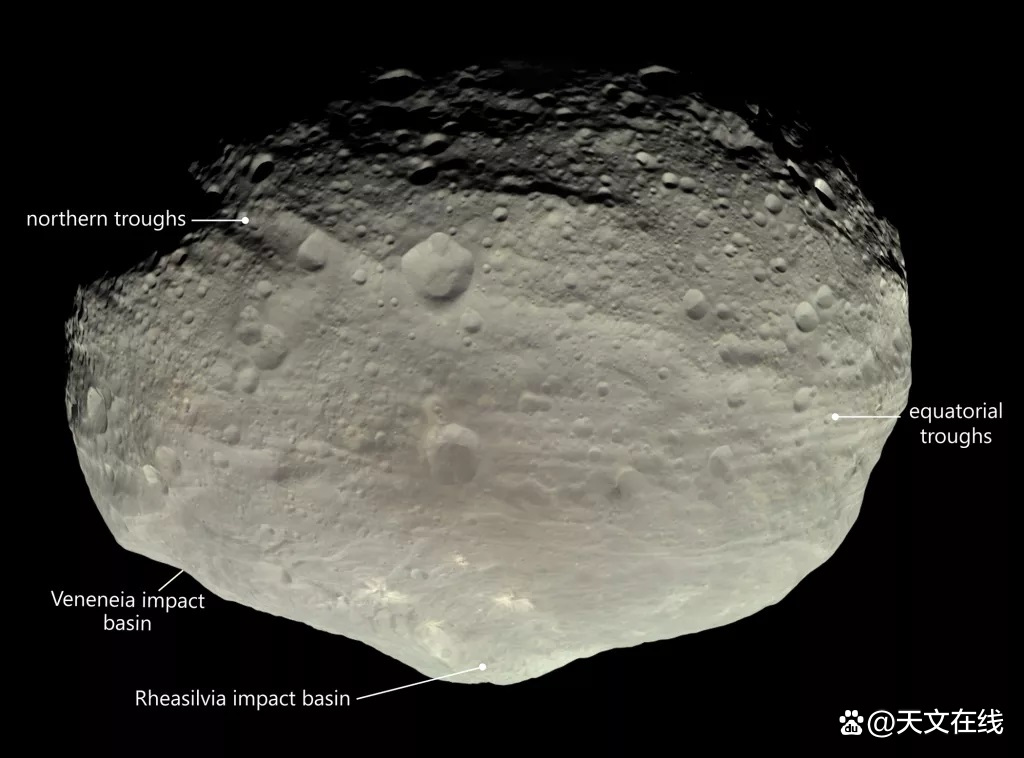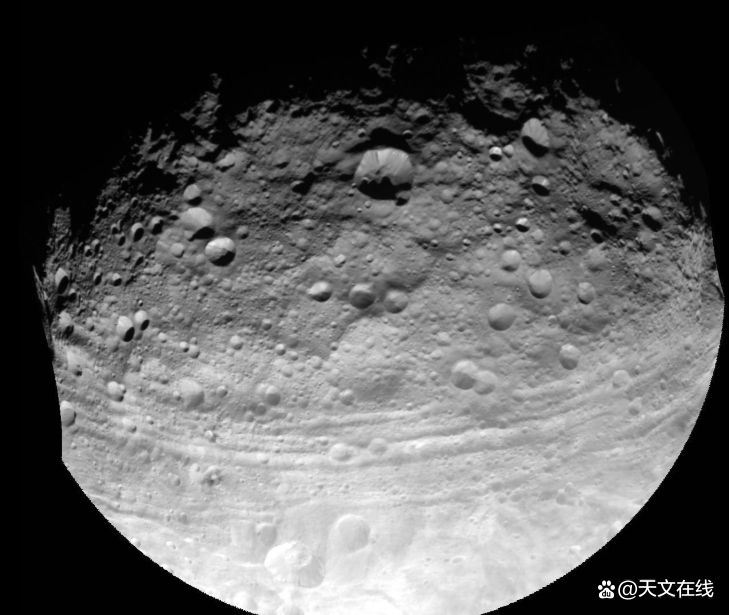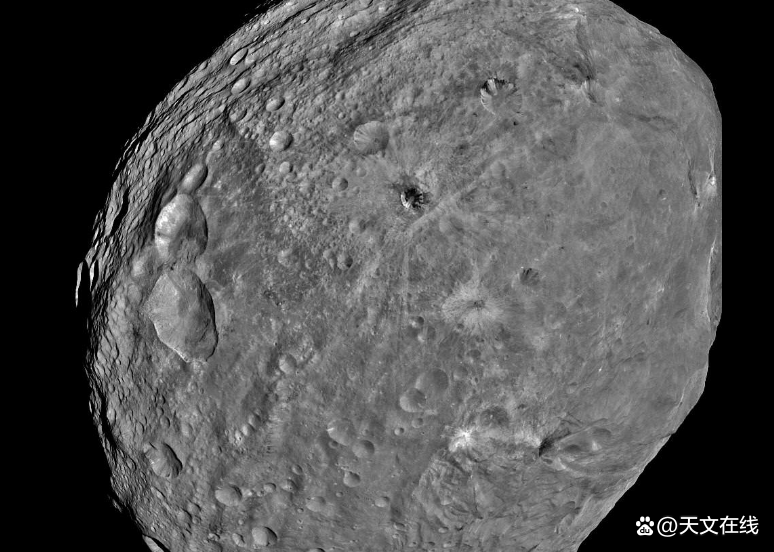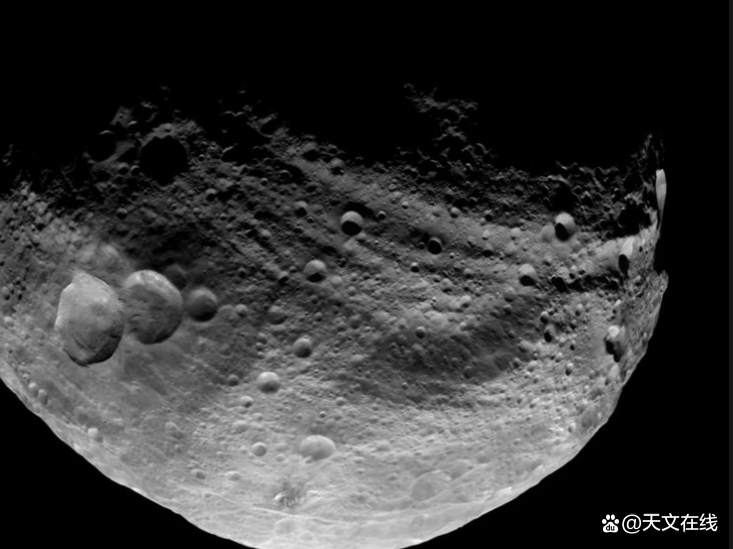What exactly is mysterious pit?The stove god star confuses astronomers
Author:Astronomy online Time:2022.09.12
Scientists continue to pay attention to the mysterious deep pit of the stove god star

Pictures of the huge impact on the basin and grooves on the stove (American Aerospace Administration/Jet Laboratory-California Polytechnic Figure)
Vesta (stove God Star) is a huge asteroid in the asteroid of the solar system (PS: The Stars of the Stove of the Stove of the Dwarf Planet Valley, the largest main asteroid, occupying 9%of the total quality of the main asteroid zone.) Essence There are two huge slot characteristics on the stove god star, and these two grooves have always troubled scientists. At present, this puzzle cannot be solved in a short period of time, and at least in recent new studies cannot be unveiled.

The US Aerospace Administration launched the Dawn Star Detector in 2011 and 2012 to visit the stove Shenxing (PS: Liming 2011 to 2012 to surround the stove Shenxing, leaving the stove Shenxing in September 2012 to go to Gu Shenxing. Starting in March 2015 Surrounded by Valley), during the mission period, the dawn was surveyed and maladed on the surface of the stove star, revealing some unprecedented details of the stove god star. In the focus of attention, it contains two huge grooves of the stove God Star, one is called the Divaria groove (PS: about 465 kilometers). planet. The other is known as the Nongshen Ji Glore (PS: about 365 kilometers) and is located in the northern hemisphere of the asteroid.

There are many assumptions about how these two huge grooves are formed, but there is an opinion that this is caused by catastrophic impact. Scientists hope to understand the formation of the formation of the stove god by revealing the process of the formation of this structure -and may help understand the formation process of other large celestial bodies in the solar system.
"The stove god star is also in the process of becoming a planet (PS: If the growth process is not unexpectedly terminated, it may become another planet of the ground), but this process is terminated in the early stage of the formation of the solar system." Come here Geologist at Georgia University, and Kristen Klimzak, a newly -research partner of the Star Star Research, said in a report, "Therefore, studying the stove god star can help us understand the earth and Our neighboring planet is forming an early situation and the process of formation. "

When the Dawn discovered these two grooves for the first time, scientists wanted to know whether the two grooves were related to whether the two impact basins of the stove star. Basin and Vennia Basin. Moreover, each groove looks surrounded by a basin, so this can't help but have associated with scientists. In these two big collisions, each collision not only produces a pits basin, but also a groove.

In the process of trying to solve this puzzle, the researchers used a commonly used tool in planet science -meteorite pit count. This technology is based on the randomness of the meteorite collision (that is, assuming that the probability of the meteorite impact in each position is the same, so the density of the meteorite pit is only related to time). The older surface will have more meteoritic pits, and the newly formed surface will be on the surface. There are fewer meteorites.

Although the method of counting the meteor pit counting cannot accurately give the surface formation time, it can be analyzed which surface formation is earlier. In addition, in the position with a lot of impacts, the impact pit at the top will be even later than the lower -level impact pit.
However, when scientists statistics and drawing the stove god star had to hit the pit, they found that there was no sufficient evidence to prove that the impact basin was linked to the groove. Therefore, the hypothetical assumption that a groove was generated while determining that a impact was generated while generating a impact basin, that is, there was no evidence that a impact of the Lea Hillvian basin and the Diwaria groove were produced. As a result, the emergence of the Vannia Basin and Gongshen Festival.

"Our research results show that the grooves and the impact basins have similar numbers of different sizes, which shows that they are similar." Jupiter Cheng, a doctoral student from Georgia University, is also one of the collaborators of this research. "However, considering the error of the meteorite pond count itself, these grooves may also be formed after the impact."
The study was published in the magazine of "Icaros".
The stove god star (the fourth asteroid discovered) is the largest planet with the asteroid (Gu Shenxing has been defined as a dwarf planet), with an average diameter of 525 kilometers (326 miles). It was discovered by German astronomer Heinli William Mattia Obes on March 29, 1807. Later, he was named Westa (the goddess in charge of family and fireplace in Roman mythology).

The stove god star (Vesta) is the second largest celestial body in the asteroid belt. It is second only to Gu Shenxing regardless of volume and quality. The measurement results show that its volume is only slightly larger than the wisdom star (about 5%larger, but considering that the measurement error is generally about 5%, the volume may be the same), but its quality is larger than the wisdom star than the wisdom star. 25%to 30%. The quality of the stove star accounts for about 9%of the total quality of the asteroid. The stove god star is the only rock -like planet known as a planet (internal layered, similar to the earth, and can be divided into three layers: the core of metal iron and nickel. It is a star shell). The fragments of many stoves of the stoves of the stoves were sprayed into the universe in about two large collisions due to two large collisions in the southern hemisphere, leaving two huge meteorites. A large amount of fragments (HED meteorites) caused by this incident fell to the earth, providing us with a large amount of information about the stove god star. From the perspective of the earth, the stove god star is the brightest asteroid. The brightness is usually about 5.1 stars. You can see it with naked eyes. Although its orbit is completely in the valley star tracks, the longest distance from the rails is slightly about the minimum distance of the sun.

The Dawn Star Detector of the US Aerospace Administration entered the stove God's track on July 16, 2011, and began a one -year detection. On September 5, 2012, he left the stove God's orbit to the final destination Valley Shenxing. At present, the researchers continue to check the stove star data collected by the dawn to further understand the formation and history of the stove god star.
By: Meghan Bartels
Fy: David is afraid to fly
If there is related content infringement, please contact the author to delete after the work is released
Reprinted, please obtain authorization, and pay attention to maintaining integrity and indicating the source
- END -
Public announcement!These 18 new occupations, quickly understand →
On the 14th, the Ministry of Human Resources and Social Security announced to 18 new occupations such as B B's Butler, Family Education Instructor, Research Travel Instructor, Robot Engineeri
Highlights!2022 National Network Security Propaganda Weekly Network Security Expo opened

Immersive anti -electrical fraud game, 5G security butler, quantum communicatio...